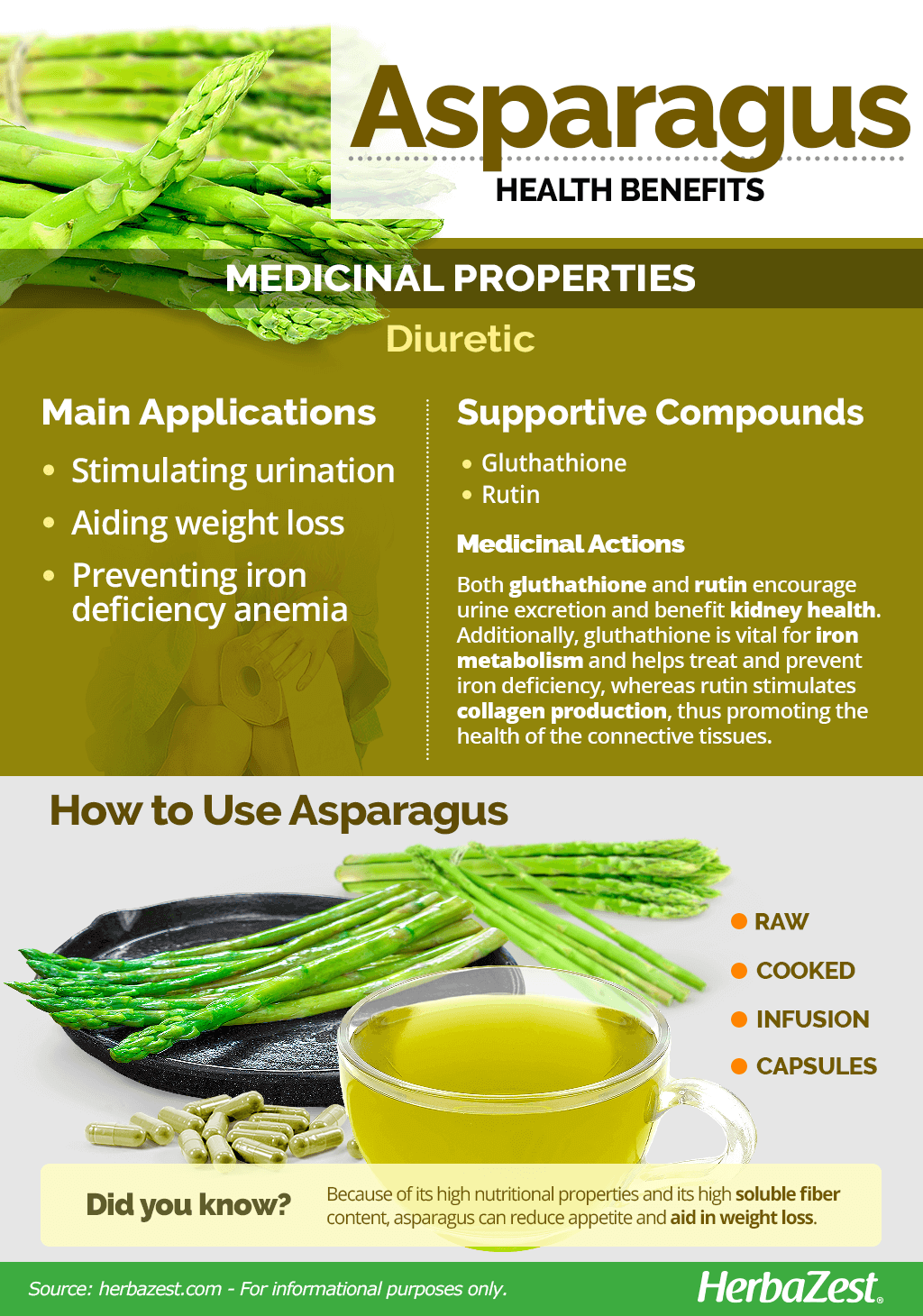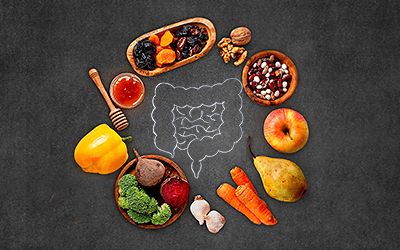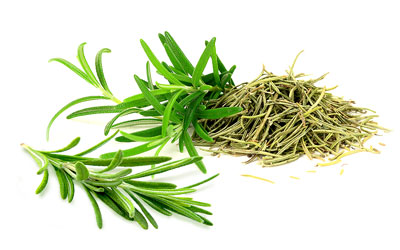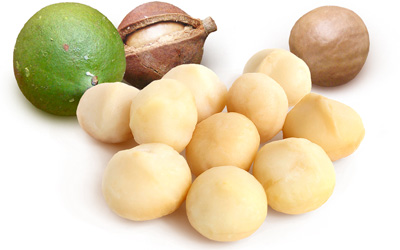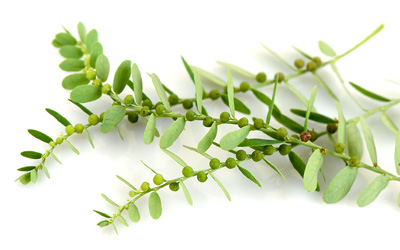Asparagus are flowering, perennial vegetables originally from Europe, Africa, and Asia. They are one of the oldest crops to have been domesticated by humans at least 5,000 years ago. Nowadays, they are cultivated in different corners of the globe, and they're gaining recognition as a nutritional and medicinal powerhouse.
Asparagus Medicinal Properties
Health Benefits of Asparagus
Considered a health-food powerhouse, asparagus are some of the most nutritionally dense vegetables in existence. The numerous asparagus' benefits include, but are not limited to, the following:
Stimulating urine excretion. Studies have shown that asparagus can encourage urine elimination, thus alleviating water retention.
In addition, many recent studies have shown asparagus can help with other functions, such as:
Aiding weight loss. Because of their high soluble fiber content, asparagus can suppress appetite and aid in overall weight loss.
Preventing iron deficiency anemia. Asparagus are rich in iron and other nutrients, which can prevent anemia.
Preventing Alzheimer's disease. Studies have shown that a diet rich nutrient-dense vegetables, such as asparagus, can reduce the likelihood of developing Alzheimer's disease.
How It Works
The main active compounds behind asparagus' medicinal properties are glutathione and rutin. Whereas the first one is a tripeptide made from three different amino acids, the latter is a glycoside; both compounds are being researched for a variety of potential uses.1
Rutin exhibits antioxidant and anti-inflammatory actions, and it aids in collagen production, thus promoting the health of the connective tissues throughout the body.2 Meanwhile, glutathione is vital for iron metabolism, and thereby helps prevent many illnesses related to iron deficiency.3 Both compounds exhibit some diuretic action.
In the past, asparagus were considered toxic to the kidneys because of the characteristic smell they give urine. Nowadays, however, it is understood that this is not the case. The diuretic properties of asparagus can actually benefit kidney health.
Finally, the combination of gluthathione, rutin, and folate that can be found in asparagus has been linked to a reduction in homocysteine levels, an amino acid whose excessive amounts have been found to contribute to the development of Alzheimer's disease.
RUTIN IN ASPARAGUS EXHIBITS ANTIOXIDANT AND ANTI-INFLAMMATORY ACTION.
Diuretic properties are also present in celery and maize, whereas parsley help prevent iron deficiency anemia.
Asparagus Side Effects
In most cases, asparagus are safe to consume in culinary form. However, they can trigger food allergies in some individuals, whether they is consumed or applied topically.
Cautions
Those who are allergic to onions or leeks may also be allergic to asparagus, so it is best to consume them with caution until any potential reactions are known.
While it is safe to consume, women who are pregnant or breastfeeding should consult their doctors before taking asparagus in medicinal dosages since they can cause hormonal fluctuations.
- Medicinal action Diuretic
- Key constituents Gluthathione, rutin
- Ways to use Capsules, Hot infusions/tisanes, Food
- Medicinal rating (3) Reasonably useful plant
- Safety ranking Safe
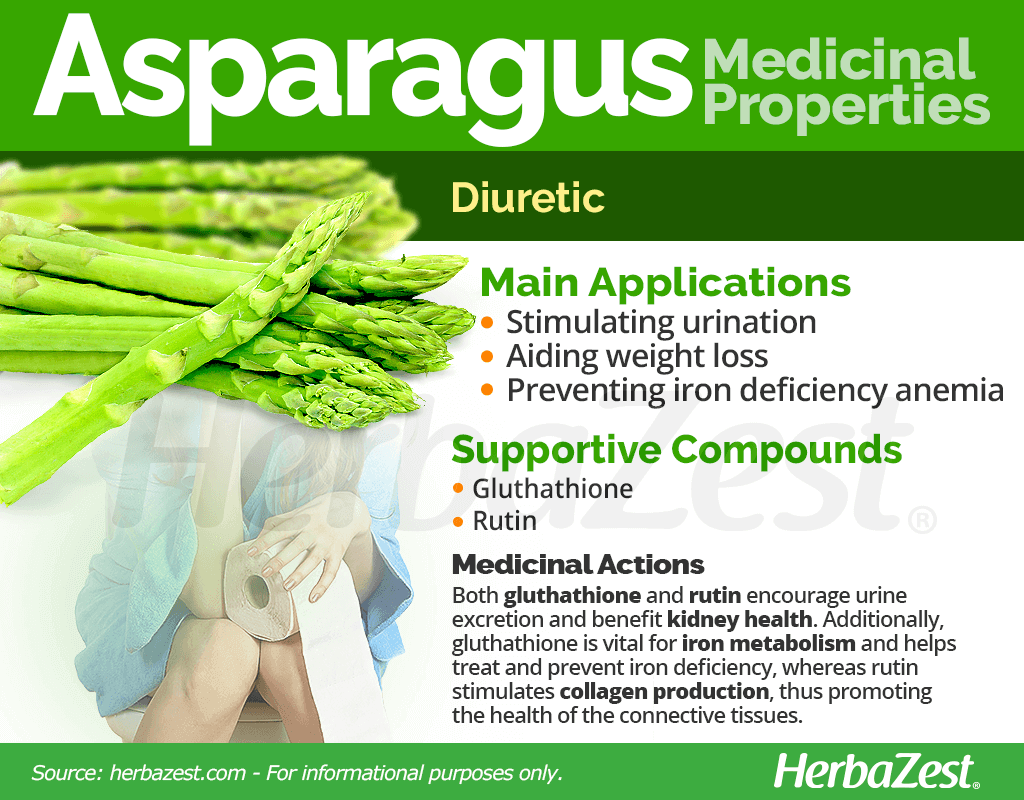
Asparagus Nutrition
The medicinal properties of asparagus are complemented by a remarkable nutritional value. They are an excellent source of vitamin K (phylloquinone), which is necessary for coagulation and helps improve bone mineral density, and vitamin B9 (folate), an important nutrient that plays a key role in fetal development, promotes the production of new red blood cells, and enhances iron absorption.
Other vitamins in asparagus, present in good amounts, are vitamin B1 (thiamin), which contributes to energy production by helping transform food into glucose; and vitamin B2 (riboflavin), an important nutrient that prevents cellular damage and plays an important role in growth as well as red blood cells production; and vitamin E (alpha-tocopherol), which supports immunity, helps prevent blood clots, and is essential for cellular functions.
Additionally, asparagus are a good source of two important minerals copper, essential for bodily functions, particularly red blood cells production, and selenium, which helps prevent cellular damage and supports thyroid hormone metabolism.
Furthermore, asparagus provide adequate amounts of other important nutrients, including vitamin C (ascorbic acid), vitamins B3 (niacin), B5 (panthotenic acid), and B6 (pyridoxine), as well as vitamin A (as carotenoids), and choline; along with minerals, such as manganese, iron, potassium, and zinc.
Interestingly, asparagus' nutrient amounts are not only higher after being cooked, but they are also better absorbed and digested in this form.
100 grams of cooked asparagus provide 22 calories and 8% of the daily value for dietary fiber.
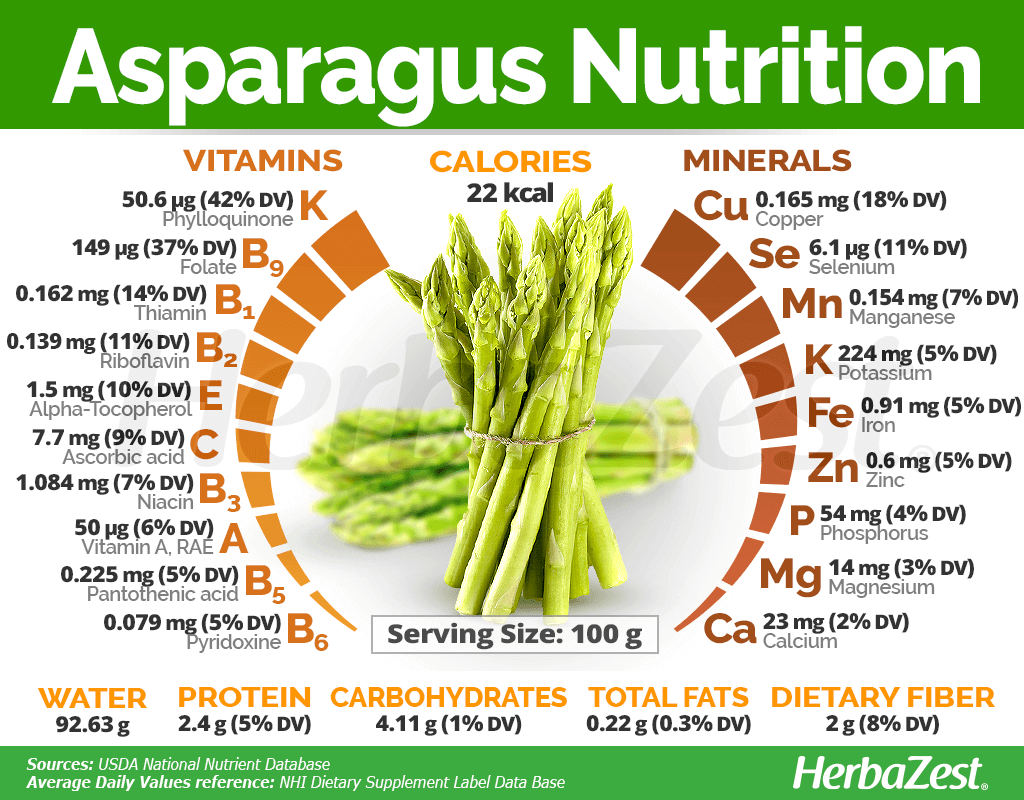
How to Consume Asparagus
While there are numerous ways to obtain asparagus' numerous health benefits, one of the most effective ways is cooking them which concentrates their properties. However, the benefits of asparagus can also be obtained from capsules and herbal remedies.
Natural Forms
Raw. In their fresh form, asparagus can stimulate urine production due to their rutin and gluthathione compounds.
Cooked. In order to make the most of asparagus nutritional value, it is better to consume them steamed or blanched. In both forms, asparagus also have diuretic properties.
Infusion. When brewed into a hot tea, asparagus infusions can help prevent iron deficiency anemia due to their gluthathione compounds.
Herbal Remedies & Supplements
Capsules. In this potent medicinal form, asparagus capsules can decrease water retention in the body through their diuretic properties.
- Edible parts Root
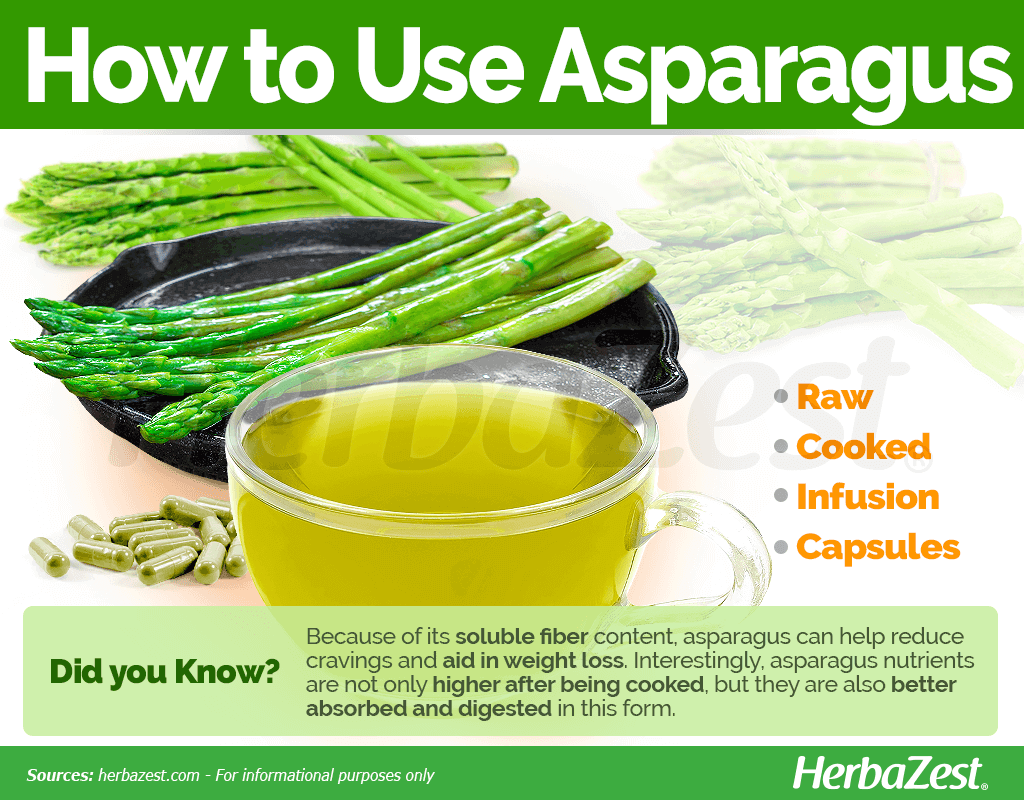
Growing
A perennial plant, asparagus are some of the earliest growing crops in the spring. If well cared for, they are incredibly hardy and can be cultivated for decades. Unlike many other herbs, asparagus are tolerant of saline soils, which can prove useful when trying to give value to otherwise fallow land. They are also considered a good companion plant for tomatoes since each plant can repel the most common pests that affect the other. For additional tips on how to help this plant thrive, follow the growing guidelines below:
Growing Guidelines
Asparagus should ideally grow in full sun, but can tolerate partial shade.
It is ideal to grow asparagus from 1-year-old, disease-free crowns to get a head start on cultivation.
Plant crowns four to six weeks before average last frost, 18 - 24 inches (45 - 60 cm) apart in trenches eight inches (20 cm) deep. Keep adding soil periodically and gradually.
Water during dry spells during the first year. Do not overwater as plants don't tolerate water-logged soils.
Fertilize in spring and fall by top-dressing with liquid fertilizer or side-dressing with a balanced organic fertilizer.
Be sure to carefully remove weeds when they crop up.
More detailed information about growing asparagus can be found in the herb garden section.
- Life cycle Perennial
- Harvested parts Roots
- Light requirements Full sun
- Soil Light (sandy)
- Soil pH 6.1 – 6.5 (Slightly acidic)
- Growing habitat Subtropical regions
- USDA Plant Hardiness Zones 3a, 3b, 4a, 4b, 5a, 5b, 6a, 6b, 7a, 7b, 8a, 8b
- Potential insect pests Beetles, Slugs, Snails
- Potential diseases Rust
Additional Information
Plant Biology
Asparagus are dioecious plants, meaning they produce male and female plants. However, only the female plants produce berries.
The full asparagus plant can grow up to 60 inches (150 cm) tall, with rhizome-type roots and small red berries. However, the most valuable part of the asparagus is the young shoots, which are used in gourmet cuisine. Although they usually go ignored, the rhizomes also contain supporting compounds that are beneficial to health.
Classification
Asparagus (Asparagus officinalis) are part of the Asparagaceae family, which comprises about 2,500 species of flowering plants across 150 genera. The Asparagus genus originally contained about 200 species; however, over half of them are native to Africa - such as A. flagellaris and A. africanus, as well as other wild relatives - and have recently been catalogued as Protosparagus, a different genus.
Asparagus species have evolved to withstand different environments. Among the drought tolerant relatives of Asparagus officinalis can be mentioned A. acutifolious (wild asparagus), A. aphyllus (Mediterranean asparagus), A. albus (white asparagus), A. stipularis, and A. scoparius, while A. tenuifolius is acid-soil resistant.
Varieties and Cultivars of Asparagus
The two main varieties of Asparagus officinalis include "proper" asparagus and purple asparagus, with the latter being more popular in Southern Europe. Although green and white asparagus are usually regarded as varieties, on a botanical level they are both the same variety of "proper" asparagus, but cultivated under different sunlight conditions.
From these two types of asparagus, many cultivars have been developed worldwide to enhance the taste and provide for better local adaptation. Among the most widespread cultivars, 'Mary Washington,' 'Jersey Knight,' and 'Precoce d'Argenteuil' can be counted.
Historical Information
Depictions of asparagus are recorded on ancient Egyptian architecture dating to around 3000 BCE, and the herb was also well-known in both Spain and Syria during ancient times. Ancient Greeks and Romans used them for culinary purposes, drying them for food during winter. In the 2nd century CE, they were mentioned as a beneficial herb by Galen, a Greek physician. By the 1400's, the asparagus were cultivated in France, reaching England and Germany during the 16th century. In the 19th century, they were introduced as culinary herbs to the Americas.
Economic Data
The United States, the European Union, and Japan comprise the top three importers of asparagus, importing over 100,000 tons between them each year. China is the top producer of the vegetable, followed by Peru and Germany. Over 7 million tons of asparagus are produced by these three countries annually. The main economic importance of asparagus is their culinary use.
Sources
- British Broadcasting Corporation, Sprue asparagus recipes
- Cornell University, Asparagus
- Drug Metabolism and Disposition: The Biological Fate of Chemicals, Food idiosyncrasies: beetroot and asparagus, 2001
- Trees of Western North America, p. 118
- University of Minessota, Growing asparagus in Minnesota home gardens
- Vegetables, pp. 94 - 96
- Wild Crop Relatives: Genomic and Breeding Resources: Vegetables, p. 30
- USDA Nutrient Database
- Medicinal Plants of the World, p. 60
- Journal of Agricultural and Food Chemistry, Constituents of Asparagus officinalis evaluated for inhibitory activity against cyclooxygenase-2, 2016
- Royal Horticultural Society, Asparagus
- Pharmacognosy Reviews, Chemical constituents of Asparagus, 2010
Footnotes:
- Pharmacognosy Review. (2010). Chemical constituents of Asparagus. Retrieved November 15, 2021, from:https://www.ncbi.nlm.nih.gov/pmc/articles/PMC3249924/
- Inflammation research. (2014). Anti-inflammatory effects of rutin on HMGB1-induced inflammatory responses in vitro and in vivo. Retrieved November 15, 2021, from: https://pubmed.ncbi.nlm.nih.gov/24292859/
- Croatian Medical Journal. (2002). Superoxide dismutase and glutathione peroxidase in erythrocytes of patients with iron deficiency anemia: effects of different treatment modalities. Retrieved November 15, 2021, from: https://pubmed.ncbi.nlm.nih.gov/11828552/
